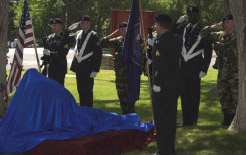Watch a video of the sculpture's unveiling ceremony.
Remembering Our Past to Assure Our Future
Donald M. Pedersen, PA-C, PhD
University of Utah Physician Assistant Program, Salt Lake City, Utah
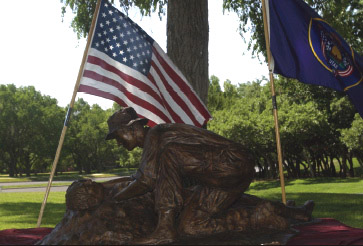
|
The military cemetery at Fort Douglas in Salt Lake City, Utah provided the backdrop on a glorious July afternoon to recall the origins of the physician assistant profession. Nearly 200 individuals joined the faculty, staff, students, and alumni of the University of Utah's physician assistant program on this hallowed site to unveil a tribute to combat medics and corpsmen and the role they played in the birth of the physician assistant profession. I've narrated the ceremony in the following pages. It is my hope you enjoy it as much as all who were able to attend.
|
|
“Lifesavers Then—Caregivers Now” With this article I hope to convey a sense of the ceremony held on July 11, 2003, to unveil the sculpture depicted above. Hopefully it will be a fitting tribute and serve as a constant reminder of the origins of a profession that continues to have “service to the underserved” as one of its basic tenets.
|
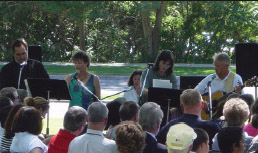 Newman Center Music Group |
|
|
Combat medics and corpsmen serving in the Vietnam conflict were the genesis of the physician assistant (PA) profession. These veterans, who provided lifesaving medical care under the most harrowing of conditions, were the inspiration for and the first enrollees in PA educational programs across the country. Their skills would have, for the most part, gone to waste had it not been for the PA movement in the United States.
|
|
|
Combat medics and corpsmen, with their extensive practical experience and additional training in PA programs across the United States have significantly increased the availability of needed primary health care services in rural and inner city communities in this country and around the globe. |
||
|
“While we are here today to celebrate the unveiling of a most beautiful statute, and to recognize a most important part of the origin of the PA profession as so eloquently stated by Don, we will accomplish more than just this task. In honoring medics and corpsmen and the PA profession, we are acknowledging once again the importance of courage in our work and in our lives. Corpsmen showed courage in their battlefield heroics in so many ways, whether it was from a foxhole, in a MASH unit behind the lines, on ships, or providing care to the population—all showed great courage. These individuals and others from the civilian sector also showed great courage in starting a new and most uncertain profession. |
|
|
|
||
|
It is not enough to cure—it is also necessary to care. Caring takes very special qualities in an individual, of which there is an abundance among PAs. These include: selflessness, self-sacrifice, empathy, and love. These qualities are expressed especially by those who provide service in underserved areas. One of the things that has impressed me most in my almost 30 years with the profession are the stories of those who serve in rural and inner city areas, or wherever medical care is hard to find. ‘To be a person of destiny is to arrive at a point in history when the only gift you have to offer has suddenly become relevant.' |
|
|
Medics and corpsmen were heroes of their time, stepping forward to save countless lives and to minimize as much human suffering as they could, while giving of themselves totally. Their services were relevant for their time in Vietnam, just as the services of those who have followed them have been relevant in the middle east, in Africa, in the Caribbean, or wherever else our military and civilian forces have been sent. These truly were people of destiny at their time and place. |
 Stephen Crane, PhD |
|
It is only right that we thank them with the sculpture that will soon be presented to us. It is only right that we honor them in this way for their courage, their compassion, as well as their heroism. Once again on behalf of the AAPA, thank you for the honor to be with you this afternoon to bring you greetings from the Academy, but most importantly to celebrate medics, corpsmen, PAs, and the worlds of curing and caring that they represent.” |
|
|
Keynote Address Next at the podium was Elmo Taylor, my friend and PA classmate. Elmo has lived the motto “Lifesaver Then—Caregiver Now.” He was a medic with the 1st Infantry Division in Vietnam from 1968–1969. He later became a physician assistant and was in the eighth class of the Utah program. He subsequently practiced at the Wayne County Clinic in Bicknell, Utah, for a dozen years—living the mission of service to the underserved. Here are his words on that day: “Throughout recorded history there has been conflict, resulting in pain and suffering—creating a need for the caregiver. |
|
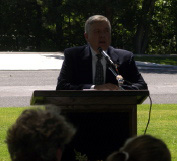 Elmo Taylor, PA-C |
After receiving military and medical training, this journey starts at the induction center of the 1st infantry division, in the jungles of Vietnam. The passing comment of a soldier out processing: “The 1st infantry division takes care of their men.” The duties of the platoon medic, responsible for the health care for approximately 30 men. With instructions that you are a rifleman first and medic second. Train to take lives before you are trained to save lives. You are respectfully referred to as “Doc.” In the heat of battle, the call is “medic.” This gives a new meaning to “medically underserved area” or “house call.”
|
|
The duty of the medic was to stabilize the patient for medivac to obtain more definitive care, oftentimes not knowing the outcome. Hoping the care was sufficient. Many paying the ultimate price. Time heals many wounds, both physical and mental. We try to remember the good times and forget the bad. As we meet this day to pay tribute to the military medic, the life saver, it is important to remember, both the good and bad.
With a desire to return to Utah, I found myself employed by a rural satellite health clinic, in Bicknell, Utah. There I was! On independent medical duty — 60 miles from the closest hospital and my supervising physician. Scared to death, and expected to know what I was doing. It soon became apparent that I had received excellent training, and the realization that I had been trained and exposed to almost every medical condition I was called on to treat. |
|
|
Artist Remembrance I didn't know John Prazen long, but he had a profound impact on me. About 2 years ago I went to John with the idea of a tribute to the combat medic. Being a former Navy corpsman he immediately seized on the idea and before I knew it—the clay sculpture was finished—and this was before we had raised one cent. That's how committed he was to this project. |
||
|
John died while his magnificent work of art was being cast at the foundry. With his passing we lost a man who was an artistic treasure. I know he would have enjoyed the day his work was unveiled and I believe he was there with us celebrating this achievement. His son Adrian was there, and shared these words with us:
|
|||
|
This project was one very close to my father's heart. As he was a corpsman himself serving aboard the USS Sperry. He had great admiration for those who serve our country. John Prazen, artist, father, mentor and friend. Thank you for the life you have given me and may the art you have given move, touch and inspire us all.”
|
||
|
Conclusion Unfortunately our world continues to struggle over differences in ideologies and outright inhumanities continue to occur. When called upon, military medics and corpsmen continue their noble tradition of standing ready to save and to heal—placing themselves in harm's way. We will not forget the sacrifices they have made in the past and the sacrifices they continue to make on a daily basis around the world. |
|||
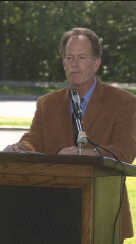 Donald Pedersen, PA-C, PhD |
Our PA profession is strong today, in large measure, due to our rich military heritage. This sculpture will serve as a constant reminder of the inextricable connection between the PA profession and our military forbears. This link should be continually celebrated with reverence and today, as a day of remembrance, will begin that process here in Utah.
I believe this work of art captures well the commitment to caring displayed by the medics and corpsmen of the past and of those presently serving our country. Thanks to the early students of PA programs, medics and corpsmen, who infused this caring attitude into our profession, the PA profession—a grand social experiment that began in the mid 1960s, with its origins firmly rooted in the military medical ethos—can only be viewed today, nearly 40 years later, as a resounding success. |
||
|
The sculpture has a permanent home at the entry way of the Utah Physician Assistant Program at the University of Utah in Salt Lake City. A pictorial history of the Combat Medic/Corpsmen Memorial Sculpture Project.
All are welcome to view the sculpture when in Salt Lake City. Please come and visit any time. The motto and trademark: “Lifesavers then—Caregivers now—Physician Assistants” has been used with permission of the Veteran's Caucus of the American Academy of Physician Assistants. |
||
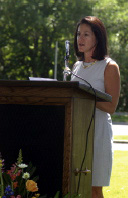 |
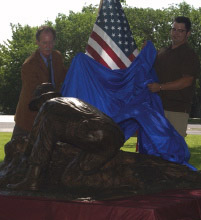 |
 |
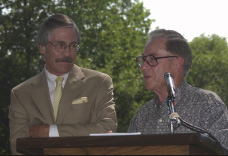 |
| Clockwise from above: Mary Ettari, PA-C, MPH, president of the PA Foundation, addresses the attendees and reflects on the origins of the profession and the foundation. Sculpture unveiled by Don Pedersen and Adrian Prazen. Dr. William Wilson and Dr. Hilmon Castle, cofounders of the Utah (MEDEX) Physician Assistant Program, share their reflections of the beginning of the program and the profession. Combat medic sculpture as displayed today outside the Utah Physician Assistant Program building. | |

